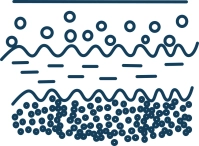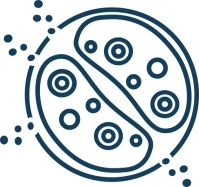Catalogue
Food Industry
In recent years, the properties of ultrasound have aroused growing interest in the food industry, since the induction of physical and chemical reactions can lead to a strategic advantage in the various stages of food processing. Ultrasound has been applied to food technologies due to its mechanical and/or chemical effects in the processes of homogenization, mixing, extraction, filtration, crystallization, dehydration, fermentation and degassing through its antifoaming actions, particle size reduction, temporary or permanent modifications of viscosity, modulation of the growth of living cells, cell destruction and dispersion of aggregates, inactivation of microorganisms and enzymes, and sterilization of equipment.
Because US offers several advantages, this form of energy has been applied to improve the qualitative characteristics of high-quality foods and to ensure the safety of a wide variety of foods, while minimizing any negative effects on the sensory characteristics of the food. Additionally, the non-destructive nature of this technology offers several opportunities for food composition analysis.
As with all other most innovative processing technologies, high power US is not a standard technology and therefore must be studied and developed for each type of application. Depending on the frequency used and the amplitude of the applied sound wave, a number of physical, chemical and biochemical effects can be used for a variety of applications. The application of high energy/intensity ultrasound improves the quality of processed foods and results in characteristics similar to the fresh product (color, consistency, flavor and nutrients).
In the food industry, ultrasound is used to control production processes, evaluate food characteristics, detect defects, monitor fruit ripening, improve the yield and extraction speed of food components, and evaluate the state of conservation. Ultrasounds have been used to improve traditional food processing operations by reducing energy and chemical requirements, thus offering a greener option.
In food processing, ultrasonic applications fall into two categories, namely replacing traditional technologies and assisting traditional technologies. In the latter case, the use of ultrasound to improve various food processes, such as extraction, freezing, thawing, brining, oxidation, filtration and drying/dehydration, increases processing efficiency and improves the disadvantages of traditional technologies used during processing prosecution.
Below are some of the applications of ultrasound in different processes:
Because US offers several advantages, this form of energy has been applied to improve the qualitative characteristics of high-quality foods and to ensure the safety of a wide variety of foods, while minimizing any negative effects on the sensory characteristics of the food. Additionally, the non-destructive nature of this technology offers several opportunities for food composition analysis.
As with all other most innovative processing technologies, high power US is not a standard technology and therefore must be studied and developed for each type of application. Depending on the frequency used and the amplitude of the applied sound wave, a number of physical, chemical and biochemical effects can be used for a variety of applications. The application of high energy/intensity ultrasound improves the quality of processed foods and results in characteristics similar to the fresh product (color, consistency, flavor and nutrients).
In the food industry, ultrasound is used to control production processes, evaluate food characteristics, detect defects, monitor fruit ripening, improve the yield and extraction speed of food components, and evaluate the state of conservation. Ultrasounds have been used to improve traditional food processing operations by reducing energy and chemical requirements, thus offering a greener option.
In food processing, ultrasonic applications fall into two categories, namely replacing traditional technologies and assisting traditional technologies. In the latter case, the use of ultrasound to improve various food processes, such as extraction, freezing, thawing, brining, oxidation, filtration and drying/dehydration, increases processing efficiency and improves the disadvantages of traditional technologies used during processing prosecution.
Below are some of the applications of ultrasound in different processes:

Characteristics
Constant improvement of existing processes and new technologies are continually introduced into the food sector, with the aim of improving production efficiency, ensuring greater safety and quality, and reducing energy costs. Therefore, food processing technologies are a sector in continuous development. Changes in consumer tastes and the need to offer increasingly safer and higher quality products imply innovative and constantly evolving research.
In fact, the introduction of new technologies can favor a reduction in processing times and an improvement in the management of processing conditions. These aspects are strictly linked to obtaining high quality products that preserve the natural characteristics of the product as much as possible. Another very important aspect that must be taken into account is the reduction of the energy requirements of the processes to limit both environmental and economic costs. Ultrasound has been applied to meat products, vegetables and fruits, cereal products, carbonated foods, honey, food gels, food proteins and food enzymes for microbial inactivation, freezing, drying and extraction, obtaining surprising results.
In fact, the introduction of new technologies can favor a reduction in processing times and an improvement in the management of processing conditions. These aspects are strictly linked to obtaining high quality products that preserve the natural characteristics of the product as much as possible. Another very important aspect that must be taken into account is the reduction of the energy requirements of the processes to limit both environmental and economic costs. Ultrasound has been applied to meat products, vegetables and fruits, cereal products, carbonated foods, honey, food gels, food proteins and food enzymes for microbial inactivation, freezing, drying and extraction, obtaining surprising results.
Crystallization

High-intensity ultrasound influences the crystallization process through the initiation of nucleation by controlling the development and formation of small crystals. Ultrasonic-assisted freezing reduces the time required to form crystals and ensures greater homogeneity, reducing cell damage and preserving product integrity. By applying ultrasound in batch mode, i.e. sonication, the sugar crystallization process is controlled by facilitating the formation of numerous nuclei from a sugar solution, and the nuclei are enhanced by the formation of well-defined crystals. This physical crystallization process occurs without the introduction of foreign substances. Sonication is applied during freezing to improve, for example, the quality of ice cream.
Ice crystals with uniform size and distribution are important contributors to product quality, and nucleation is the most important factor controlling crystal formation and distribution during freezing.
Ice crystals with uniform size and distribution are important contributors to product quality, and nucleation is the most important factor controlling crystal formation and distribution during freezing.
Emulsion

Emulsions and dispersions often contain surfactants to increase stability. Surfactants inhibit the agglomeration of material dispersed in the liquid phase. In fact, the surfactants form a layer around each particle. However, the same surfactants can encapsulate gas bubbles suspended in the liquid phase, which are substantially stabilized.
In this way, the surfactant is consumed, the quality of the emulsion or dispersion is reduced and erroneous particle size readings are generated. Liquids are simply degassed by sonication to reduce the problem of stabilized gas bubbles, reducing the number of bubbles and promoting emulsification. The implosion of a cavitation bubble along the interface between two immiscible liquids generates a highly stable emulsion, even at low energy. In the food sector, high-energy, low-frequency ultrasound waves are also specifically used to generate emulsions, mayonnaise, fruit juices, ketchup and homogenized milk.
In this way, the surfactant is consumed, the quality of the emulsion or dispersion is reduced and erroneous particle size readings are generated. Liquids are simply degassed by sonication to reduce the problem of stabilized gas bubbles, reducing the number of bubbles and promoting emulsification. The implosion of a cavitation bubble along the interface between two immiscible liquids generates a highly stable emulsion, even at low energy. In the food sector, high-energy, low-frequency ultrasound waves are also specifically used to generate emulsions, mayonnaise, fruit juices, ketchup and homogenized milk.
Extraction

The mechanical effects facilitate greater penetration of the solvent into the cells, improving the transfer and the cavitation effect, which causes the cell walls to break and release their contents into the medium. Therefore, with this technology, higher yields are obtained in less time with lower processing temperatures. Furthermore, several applications have demonstrated that ultrasonic-assisted extraction represents an ecologically and economically viable alternative to conventional techniques for foods and natural products.
Antifoam action

Antifoaming and defoaming treatment of liquids are interesting applications of ultrasound. In fact, ultrasound forces small bubbles suspended in the liquid to rise to the surface and release the trapped gas into the environment, thus reducing the level of dissolved gas below the level of the liquid. Therefore, ultrasonic treatment is used to obtain carbonated beverages without foam, in fermentation systems or in other processes where foam worsens the quality of the products.
Fermentation

At high intensity, ultrasound disrupts cells and/or denatures enzymes. At low intensity, it enhances the mass transfer of reactants and products across the interface or through the cell wall. Ultrasound has been used in these processes to monitor the progress of fermentation or to influence its progression. Additionally, it has also been used to eliminate microorganisms that might otherwise hinder the process.
Pasteurization

The combination of ultrasound with heat treatment is effective at low temperatures and subsequently improves product quality. Ultrasonic pasteurization at 50 ◦C has the potential to preserve the quality of many food products in terms of physicochemical properties, color and flavor compared to conventional pasteurization techniques that involve much higher temperatures and higher energy costs.
Filtration

The vibrational energy generated by ultrasound allows the particles to remain in suspension and continue moving, leaving the filter surfaces free and facilitating the passage of the solvent into the pores.
Catalogue
Download our catalog with all the information about our technology, equipment and applications.
Can we help you with anything else?
Call without obligation at 960 26 36 65 or contact us through the form
COMPARISON TABLE

Flow cell 2kWView Product |

Flow cell 4kWView Product |
|
| Exterior dimensions LxWxH (mm) | 926 x 442 x 310 | 1852 x 442 x 310 |
| Maximum consumption (kVA) | 2 | 4 |
| Work frequency (kHz) | 24 - 25 - 28 - 33 | 24 - 25 - 28 - 33 |
| IP protection clas | 54 | 54 |
| Fluid temperature (ºC) | 5 - 25 | 5 - 25 |
| Maximum system temperature (ºC) | 65 | 65 |
| Maximum working pressure (bar) | 3 | 3 |
| Pressure inlet for cooling (bar) | 5.5 | 5.5 |
| Communication protocol | Modbus RS 485 RTU | Modbus RS 485 RTU |
Products
Equipment range
Where to use our industrial ultrasonic devices
Work areas
Contact
How can we help you?
Do you have any questions or queries or need to hire our services? Contact us through this simple form, we will answer you as soon as possible. Thank you!!



